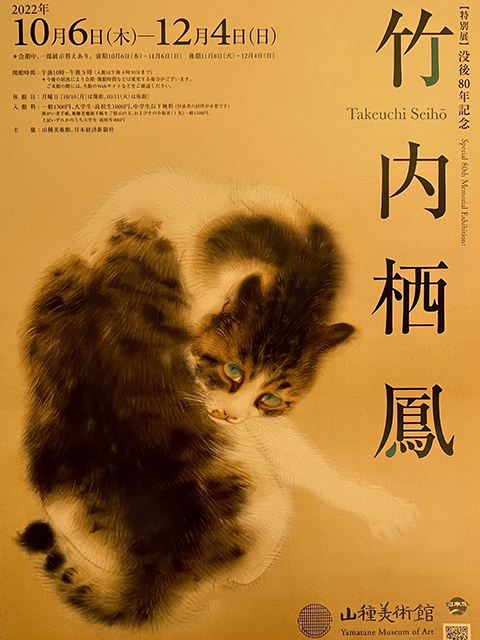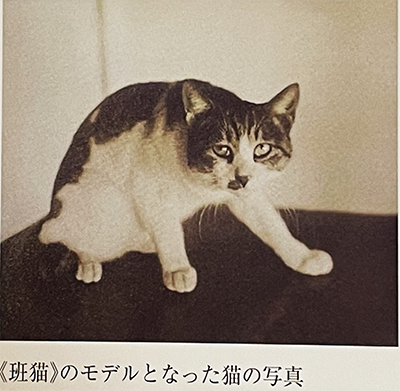

7泊8日の久しぶりの長期出張から札幌に帰還。
いろんなToDoが積み重なっていますが、きのうはカミさんとあちこち。
で、土曜日に鑑賞してきた山種美術館での「斑猫」が気に掛かる。
日本画家の竹内栖鳳の代表作で重要文化財指定を受けている。
1週間以上の出張で息つく暇もなかったので
最後の日の午前から飛行機の時間までしばし恵比寿・広尾を美術散歩。
だんだん絵の好みというのは絞られていくのでしょうが、
わたしの場合は歴史好きが際だってきたこともあってか、伝統的な感受性、
日本人的な「ものの見方」を反映したものに収斂してきた。
それこそ縄文の土偶からはじまってくる感受性は
大和絵、鳥獣戯画みたいな諧謔性もはらみながら
現代のマンガ文化に至るまでの大きな流れを感じさせられる。
そういうことなので山種美術館と東京国立博物館の展示がホーム感。
ただ今回は東京国立博物館は全国宝展示で予約者だけという限定なので
予定がつかなかったので諦めました。
仕方ない側面があるとはいえ、文化鑑賞に於いて予約だけというのは
あんまり同意できない。
忙しい人間ほど、こころの空洞が拡大する傾向があり、
それを根底から癒すような役割が文化芸術には必須なのではないかと。

わたしはネコにはあまり興味は無い方です。
どっちかというとイヌの方が好みに合っている。
ネコはいかにも独立不羈という内面を感じさせられ遠慮する部分がある。
しかし最近娘が飼っていた愛ネコが旅立ったこともあって
その娘の心情をおもんばかる気分で「ピーちゃん」の目線を思い出していた。
たまたま山種美術館でこの同じ斑猫の絵と出会った次第。
ふと「この絵の写真を娘に」とも考えたがやはり止めた。
ようやく時間の忘却が始まるときに再度揺り戻すように感じた。
この作品は作家の竹内栖鳳さんが沼津市内を歩いていたときに
ある八百屋の店先で荷車の上で寝ていたこの猫と遭遇。
「ははぁ、徽宗皇帝の猫がいるぞ」とコトバを発したのだという。
〜徽宗は北宋の第8代皇帝。書画の才に優れ北宋最高の芸術家の一人と言われる。
一方政治的無能で治世には人民は悪政に苦しみ宋江の乱など地方反乱が頻発。〜
その徽宗の描いた有名な猫の絵があって画家のインスピレーションを刺激した。
しかしその猫は八百屋の女将さんの愛猫で画家の手許に渡るには
ずいぶんと逸話があってようやくこの猫は沼津から画家の京都の自邸に移った。
しばし画家の手許で創作のモデル役を果たした後、
いずこともなく消息を絶ったのだという。
猫にして見ればやむなく画家の勝手に付き合わされたけれど、
役目を果たしてのちは猫本然の独立不羈の生き方に回帰したのだろうか。
わが娘の愛猫は結局、娘の腕の中で旅立っていったと聞いたけれど
画家のモデル猫とどっちがシアワセだったか、誰にもわからないでしょうね。
English version⬇
Seiho Takeuchi’s “Spotted Cat” and his daughter’s cat “Pi-chan”.
A Japanese painting work designated as an Important Cultural Property. This is a seperate reproduction from a painting of a cat by Emperor Huizong in the Song dynasty. On the other hand, the daughter’s beloved cat departed in the arms of her daughter. …
I returned to Sapporo after a long business trip of 7 nights and 8 days.
Various to-dos are piling up, but yesterday I was here and there with Kami.
On Saturday, I went to the Yamatane Museum of Art to see “Spotted Cat,” a masterpiece by the Japanese painter Takeuchi Seiho, which is designated as an important cultural asset.
It is a representative work by Japanese painter Seiho Takeuchi and is designated as an important cultural property.
I was on a business trip for more than a week and had no time to catch my breath.
On my last day, I strolled around Ebisu and Hiroo until it was time for my flight.
I guess my taste in art is gradually narrowing down, but in my case, my love of history is more pronounced.
In my case, my love of history has become more pronounced, and I have a traditional sensibility and a Japanese “way of seeing things” to reflect.
I have converged on works that reflect the traditional Japanese way of looking at things, perhaps due in part to my growing love of history.
This is exactly the kind of sensitivity that began with Jomon clay figurines.
While also containing humorous elements such as Yamato-e and Birds and Beasts caricatures, it is a major current in the contemporary manga culture.
It is a major flow that has led to the modern manga culture.
For this reason, the exhibitions at the Yamatane Museum of Art and the Tokyo National Museum are homey.
However, the Tokyo National Museum’s exhibition of all treasures is limited to those who have made reservations, so I had to give up.
I couldn’t make plans, so I gave up.
Although there are some aspects that cannot be helped, I do not agree that reservations are the only way to appreciate culture.
I don’t really agree with it.
The busier we are, the more our mental void tends to expand.
I think that culture and art must play a role to heal the void from the bottom up.
I am not a big fan of cats.
Canines are more to my liking.
Cats are more reserved, as they seem to have an inner independence.
However, my daughter’s beloved cat recently passed away.
I was reminded of “Pi-chan,” a cat with a spotted eye, because I was concerned for her feelings.
I happened to come across a painting of the same cat at the Yamatane Museum of Art.
I thought of taking a picture of this painting for my daughter, but decided against it.
I felt as if I was being jolted back into the oblivion of time at last.
This work was painted by the artist Seiho Takeuchi when he was walking in Numazu City.
He encountered this cat sleeping on a cart at a grocery store.
He said, “Ha ha, there is the cat of Emperor Huizong.
〜Huizong was the eighth emperor of the Northern Song dynasty. He excelled in calligraphy and painting and is considered one of the greatest artists of the Northern Song dynasty.
He was one of the greatest artists of the Northern Song dynasty, but his politics were incompetent, and during his reign the people suffered from maladministration and frequent local rebellions such as the Song River Rebellion. 〜The Sung Jiang Rebellion
The famous cat painted by Huizong inspired the artist.
However, the cat was the beloved cat of a grocer’s landlady, and there is a long anecdote about how it came to be in the hands of the painter.
After a long anecdote, the cat was finally moved from Numazu to the artist’s own residence in Kyoto.
After serving as a model for the artist for a while, the cat disappeared without a trace.
The cat was then never seen or heard from again.
The cat was forced to go along with the painter’s whims, but after fulfilling its role, it became the cat’s natural habitat.
After fulfilling its role, did the cat return to its natural way of life as an independent, free-spirited creature?
I heard that my daughter’s beloved cat eventually departed in the midst of my daughter.
I guess no one will ever know who was more happy, the painter’s model cat or my daughter’s cat.
Posted on 10月 31st, 2022 by 三木 奎吾
Filed under: こちら発行人です, 日本社会・文化研究







コメントを投稿
「※誹謗中傷や、悪意のある書き込み、営利目的などのコメントを防ぐために、投稿された全てのコメントは一時的に保留されますのでご了承ください。」
You must be logged in to post a comment.